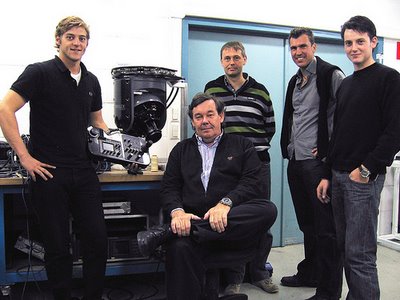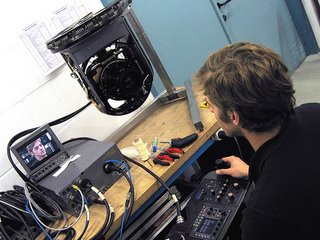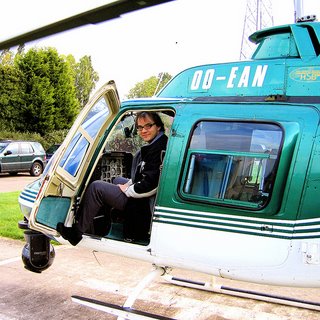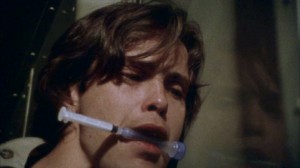When the trans-channel ferry, Herald Of Free Enterprise, capsized in March 1987, a Belgian photographer working with the BBC was handed the responsibility of organizing all aerial photography of the disaster. For search & rescue, forensic analysis, and breaking news for an anxious populace, it was essential to collect as much aerial footage as possible, and as quickly as possible. Young Wim Robberechts called every aerial camera crew in the United Kingdom and so entered a niche he would occupy for the next 20 years, and eventually come to dominate.
Aerial cinematography is like the shooting of complicated visual effects – substantial sums are spent for a few seconds of footage, a crack team operates sophisticated equipment under the microscopic gaze of panicked producers, and in the end the director takes all the credit.
In a recent example from Michael Palin’s “New Europe” (2007), the ex-Python is seen through the window of a DC-3 and then slowly drifts away in a massive pull back that dwarfs both him and the plane. The shot was captured by one of Robberechts’s young operators, Evert Cloetens Vandenbranden, using the Cineflex, which has become the gold standard for gyro-stabilized aerial camera mounts. It was the only shot Wim Robberechts & Co. did for the Palin series, yet it is likely to be one of the show’s most memorable moments.

Wim Robberechts & Co. has long employed Wescam helicopter mounts, for years an industry workhorse, but the foundation of the company is its three Cineflexes. The Cineflex is a gyro stabilized HD camera unit that allows for rock-steady camera support on unstable or fast-moving platforms. It has been used extensively in feature films and news gathering and is a mainstay of sporting events. Viewers gasped at the recent spectacular HD aerial shots of Groupe SFP’s Tour de France coverage – captured by a Cineflex from Wim Robberechts & Co. The upcoming Olympic games in China will feature Cineflex mounts from several countries. The BBC’s “Planet Earth” (2006) was the first nature documentary to employ the Cineflex, stunning us not only with superb HD images, but intimate aerial views of wildlife which would not have been possible with previous systems.
 Though Robberechts is himself a broadcast industry veteran, he deliberately employs a youthful team of technicians, some straight out of Belgium’s top film school, to help keep his edge sharp. “Some of these directors, the ones with the half-shaved face and expensive sunglasses, they are not going to speak the same language as me.”
Though Robberechts is himself a broadcast industry veteran, he deliberately employs a youthful team of technicians, some straight out of Belgium’s top film school, to help keep his edge sharp. “Some of these directors, the ones with the half-shaved face and expensive sunglasses, they are not going to speak the same language as me.”
Robberechts is invited to give regular lectures at the Brussels Film School and when there, he keeps an eye out for new talent. His years of experience have dictated a clear, hard-line set of criteria for potential applicants. “You must be able to speak at least three languages, and be willing to work for little money for two years. And say goodbye to any girlfriend or family life.” The training is intensive and all done in-house. “For the first two years, it costs more money to train a new operator than he brings into the company.” The commitment level must therefore be very high and Robberechts accepts nothing less than 100% commitment.
The beginning of a technician’s training might involve little more than riding in the chase van during the filming of a bicycle race, and might culminate with a first aerial shoot of power lines commissioned by the local government. Young company technician Evert Cloetens, an employee still in the middle of a long and steep education, earned his first solo shoot at Torino, shooting the downhill skiing. The Cineflex was mounted on the CAMCAT remote control cable camera system. While another company’s technician handled the CAMCAT, Evert, seated at controls beside the CAMCAT tech, captured the HD footage with the Cineflex. Evert is also an enthusiastic skydiver and skydiving camera operator, but, at present, Robberechts has no plans to add skydive photography to his rate sheet.
Operator Bas Vandenbranden came directly out of film school to join Wim Robberechts & Co. In addition to having the “right stuff”, he had a passion for remote control model aircraft. Some of Bas’s early years were spent rigging up timer-set Polaroid cameras to small balloons – then chasing the Polaroid photographs they it floated, leaf-like, back to earth. He has also just returned from shooting San Diego’s Red Bull Air Race with the Cineflex.
 Robberechts briefly expanded with the addition of a Paris office, but he quickly abandoned the foray. The current situation in Brussels was hard to improve upon. Brussels is, if you include English, a tri-lingual city. Its designation as the economic hub of Europe puts it at the financial and political center of things, and its geography allows rapid, easy access to Britain or anywhere in continental Europe via air or Belgium’s straight, wide roads.
Robberechts briefly expanded with the addition of a Paris office, but he quickly abandoned the foray. The current situation in Brussels was hard to improve upon. Brussels is, if you include English, a tri-lingual city. Its designation as the economic hub of Europe puts it at the financial and political center of things, and its geography allows rapid, easy access to Britain or anywhere in continental Europe via air or Belgium’s straight, wide roads.
Technologies like the Cineflex demand a new way of employing aerial photography. It is no longer sufficient to show viewers high resolution images shot from a great height without also giving attention to aesthetics. With the dollar weak, Europeans are buying up the American-made Cineflex at a tremendous rate. As the technology becomes ubiquitous, the art of the aerial shot – its beauty, its dramatic context, its resonance – will come to the fore. Robberechts’s crew are likely to exchange the designation “operator” for “artist”.
